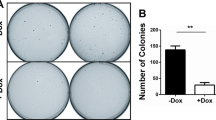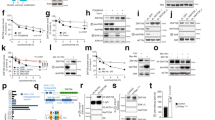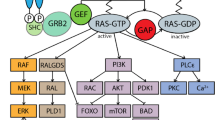Abstract
Ras oncogene upregulates the expression of nicotinamide adenine dinucleotide phosphate oxidase (Nox) 1 via the Raf/MEK/ERK pathway, leading to the elevated production of reactive oxygen species that is essential for maintenance of Ras-transformation phenotypes. However, the precise transcriptional control mechanism underlying Ras-induced Nox1 expression remains to be elucidated. Here we demonstrated that via the MEK/ERK pathway, Ras signaling enhances the activity of the functional Nox1 promoter (nt −321 to −1) in colon cancer CaCo-2 cells and thereby induces the formation of the specific protein–DNA complexes in the two GATA-binding site-containing regions (nt −161 to −136 and −125 to −100). Supershift assays with GATA antibodies, protein analyses and chromatin immunoprecipitation revealed that GATA-6 is a component of the specific protein–DNA complexes at the Nox1 promoter. GATA-6 was able to trans-activate the Nox1 promoter but not a promoter in which the GATA-binding sites are mutated. Moreover, GATA-6 was phosphorylated at serine residues by MEK-activated ERK, which increased GATA-6 DNA binding, correlating with suppression of the Nox1 promoter activity by an MEK inhibitor PD98059. Finally, the site-directed mutation of the consensus ERK phosphorylation site (PYS120P to PYA120P) of GATA-6 abolished its trans-activation activity, suppressing of the growth of CaCo-2 cells. On the basis of these results, we propose that oncogenic Ras signaling upregulates the transcription of Nox1 through MEK-ERK-dependent phosphorylation of GATA-6.
This is a preview of subscription content, access via your institution
Access options
Subscribe to this journal
Receive 50 print issues and online access
$259.00 per year
only $5.18 per issue
Buy this article
- Purchase on Springer Link
- Instant access to full article PDF
Prices may be subject to local taxes which are calculated during checkout








Similar content being viewed by others
References
Adachi Y, Pavlakis GN, Copeland TD . (1994). Identification and characterization of SET, a nuclear phosphoprotein encoded by the translocation break point in acute undifferentiated leukemia. J Biol Chem 269: 2258–2262.
Akiyama Y, Watkins N, Suzuki H, Jair KW, Engeland MV, Esteller M et al. (2003). GATA-4 and GATA-5 transcription factor genes and potential downstream antitumor target genes are epigenetically silenced in colorectal and gastric cancer. Mol Cell Biol 23: 8429–8439.
Arbiser JL, Petros J, Klafter R, Govindajaran B, Mclaughlin ER, Brown LF et al. (2002). Reactive oxygen generated by Nox1 triggers the angiogenenic switch. Proc Natl Acad Sci USA 99: 715–720.
Bánfi B, Molnár G, Maturana A, Steger K, Hegedus B, Demaurex N et al. (2001). A Ca2+-activated NADPH oxidase in testis, spleen, and lymph nodes. J Biol Chem 276: 37594–37601.
Bokoch GM . (1994). Regulation of the human neutrophil NADPH oxidase by the Rac GTP-binding proteins. Curr Opin Cell Biol 6: 212–218.
Brewer AC, Sparks EC, Shah AM . (2006). Transcriptional regulation of the NADPH oxidase isoform, Nox1, in colon epithelial cells: role of GATA-binding factor(s). Free Radic Biol Med 40: 260–274.
Cheng G, Cao Z, Xu X, van Meir EG, Lambeth JD . (2001). Homologs of gp91phox: cloning and tissue expression of Nox3, Nox4, and Nox5. Gene 269: 131–140.
Chu D, Kakazu N, Gorrin-Rivas MJ, Lu HP, Kawata M, Abe T et al. (2001). Cloning and characterization of LUN, a novel RING finger protein that is highly expressed in lung and specifically binds to a palindromic sequence. J Biol Chem 276: 14004–14013.
Debruyne PR, Vermeulen SJ, Berx G, Pocard M, Correia da Rocha AS, Li X et al. (2003). Functional and molecular characterization of the epithelioid to round transition in human colorectal cancer LoVo cells. Oncogene 22: 7199–7208.
Eklund EA, Jalava A, Kakar R . (1998). PU.1, interferon regulatory factor 1, and interferon consensus sequence-binding protein cooperate to increase gp91phox expression. J Biol Chem 273: 13957–13965.
Fang R, Olds LC, Santiago NA, Sibley E . (2001). GATA family transcription factors activate lactate gene promoter in intestinal Caco-2 cells. Am J Physiol Gastrointest Liver Physiol 280: G58–G67.
Fensterer H, Giehl K, Buchholz M, Ellenrieder V, Buck A, Kestler HA et al. (2004). Expression profiling of the influence of RAS mutants on the TGFB1-induced phenotype of the pancreatic cancer cell line PANC-1. Genes Chromosomes Cancer 39: 224–235.
Fu X, Beer DG, Behar J, Wands J, Lambeth D, Cao W . (2006). cAMP-response element-binding protein mediates acid-induced NADPH oxidase NOX5-S expressionBarrett esophageal adenocarcinoma cells. J Biol Chem 281: 20368–20382.
Gao X, Sedgwick T, Shi YB, Evans T . (1998). Distinct functions are implicated for the GATA-4, -5, and -6 transcription factors in the regulation of intestine epithelial cell differentiation. Mol Cell Biol 18: 2901–2911.
Geiszt M, Kopp JB, Várnai P, Leto TL . (2000). Identification of renox, an NAD(P)H oxidase in kidney. Proc Natl Acad Sci USA 97: 8010–8014.
Geiszt M, Lekstrom K, Brenner S, Hewitt SM, Dana R, Malech HL et al. (2003). NAD(P)H oxidase 1, a product of differentiated colon epithelial cells, can partially replace glycoprotein 91phox in the regulated production of superoxide by phagocytes. J Immunol 171: 299–306.
Hernandez-Hernandez A, Ray P, Litos G, Ciro M, Ottolenghi S, Beug H et al. (2006). Acetylation and MAPK phosphorylation cooperate to regulate the degradation of active GATA-1. EMBO J 25: 3264–3274.
Kawahara T, Kuwano Y, Teshima-Kondo S, Takeya R, Sumimoto H, Kishi K et al. (2004). Role of nicotinamide adenine dinucleotide phosphate oxidase 1 in oxidative burst response to Toll-like receptor 5 signaling in large intestinal epithelial cells. J Immunol 172: 3051–3058.
Kitta K, Day RM, Kim Y, Torregroza I, Evans T, Suzuki YS . (2003). Hepatocyte growth factor induces GATA-4 phosphorylation and cell survival in cardiac muscle cells. J Biol Chem 278: 4705–4712.
Lambeth JD . (2004). NOX enzymes and the biology of reactive oxygen. Nat Rev Immunol 4: 181–189.
Lambeth JD, Cheng G, Arnold RS, Edens WA . (2000). Novel homologs of gp91phox. Trends Biochem Sci 25: 459–461.
Lassègue B, Sorescu D, Szocs K, Yin Q, Akers M, Zhang Y et al. (2001). Novel gp91phox homologues in vascular smooth muscle cells: nox1 mediates angiotensin II- induced superoxide formation and redox-sensitive signaling pathways. Circ Res 88: 888–894.
Luo W, Skalnik DG . (1996). Interferon regulatory factor-2 directs transcription from the gp91phox promoter. J Biol Chem 271: 23445–23451.
Mahadev K, Motoshima H, Wu X, Ruddy JM, Arnold RS, Chang G et al. (2004). The NAD(P)H oxidase homolog Nox4 modulates insulin-stimulated generation of H2O2 and plays an integral role in insulin signal transduction. Mol Cell Biol 24: 1844–1854.
Mitsushita J, Lambeth JD, Kamata T . (2004). The superoxide-generating oxidase Nox1 is functionally required for Ras oncogene transformation. Cancer Res 64: 3580–3585.
Molkentin JD . (2000). The zinc finger-containing transcription factors GATA-4, -5, and -6. Ubiquitously expressed regulators of tissue-specific gene expression. J Biol Chem 275: 38949–38952.
Morimoto T, Hasegawa K, Kaburagi S, Kakita T, Wada H, Yanazume H et al. (2000). Phosphorylation of GATA-4 is involved in α1-adrenergic agonist-responsive transcription of the endothelin-1 gene in cardiac myocytes. J Biol Chem 275: 13721–13726.
Nelson JD, Denisenko O, Bomsztyk K . (2006). Protocol for the fast chromatin immunoprecipitation (ChIP) method. Nat Protoc 1: 179–185.
Newburger PE, Ezekowitz RA, Whitney C, Wright J, Orkin SH . (1988). Induction of phagocyte cytochrome b heavy chain gene expression by interferon γ. Proc Natl Acad Sci USA 85: 5215–5219.
Paffenholz R, Bergstrom RA, Pasutto F, Wabnitz P, Munroe RJ, Jagla W et al. (2004). Vestibular defects in head-tilt mice result from mutations in Nox3, encoding an NADPH oxidase. Genes Dev 18: 486–491.
Patient RK, McGhee JD . (2002). The GATA family (vertebrates and invertebrates). Curr Opin Genet Dev 12: 416–422.
Suh YA, Arnold RS, Lassegue B, Shi J, Xu X, Sorescu D et al. (1999). Cell transformation by the superoxide-generating oxidase Mox1. Nature 401: 79–82.
Suzuki E, Evans T, Lowry J, Truong L, Bell DW, Testa JR et al. (1996). The human GATA-6 gene: structure, chromosomal location, and regulation of expression by tissue-specific and mitogen-responsive signals. Genomics 38: 283–290.
Tenhunen O, Sarman B, Kerkela R, Szokodi I, Papp L, Toth M et al. (2004). Mitogen-activated protein kinase p38 and ERK 1/2 mediate the wall stress-induced activation of GATA-4 binding in adult heart. J Biol Chem 279: 24852–24860.
Yu YL, Chiang YJ, Chen YC, Papetti M, Juo CG, Skoultchi AI et al. (2005). MAPK-mediated phosphorylation of GATA-1 promotes Bcl-XL expression and cell survival. J Biol Chem 280: 29533–29542.
Acknowledgements
We thank Dr J Downward, Dr E Nishida and Dr M Maeda for plasmid DNAs. This study was supported by Grant-in-Aid for Scientific Research on Priority Areas from the Ministry of Education, Culture, Sports, Science and Technology of Japan (TK).
Author information
Authors and Affiliations
Corresponding author
Rights and permissions
About this article
Cite this article
Adachi, Y., Shibai, Y., Mitsushita, J. et al. Oncogenic Ras upregulates NADPH oxidase 1 gene expression through MEK-ERK-dependent phosphorylation of GATA-6. Oncogene 27, 4921–4932 (2008). https://doi.org/10.1038/onc.2008.133
Received:
Revised:
Accepted:
Published:
Issue Date:
DOI: https://doi.org/10.1038/onc.2008.133
Keywords
This article is cited by
-
Low dose radiation upregulates Ras/p38 and NADPH oxidase in mouse colon two months after exposure
Molecular Biology Reports (2023)
-
The deubiquitinase USP16 functions as an oncogenic factor in K-RAS-driven lung tumorigenesis
Oncogene (2021)
-
Current updates on the role of reactive oxygen species in bladder cancer pathogenesis and therapeutics
Clinical and Translational Oncology (2020)
-
Subverted regulation of Nox1 NADPH oxidase-dependent oxidant generation by protein disulfide isomerase A1 in colon carcinoma cells with overactivated KRas
Cell Death & Disease (2019)
-
NF-κB-induced NOX1 activation promotes gastric tumorigenesis through the expansion of SOX2-positive epithelial cells
Oncogene (2019)



